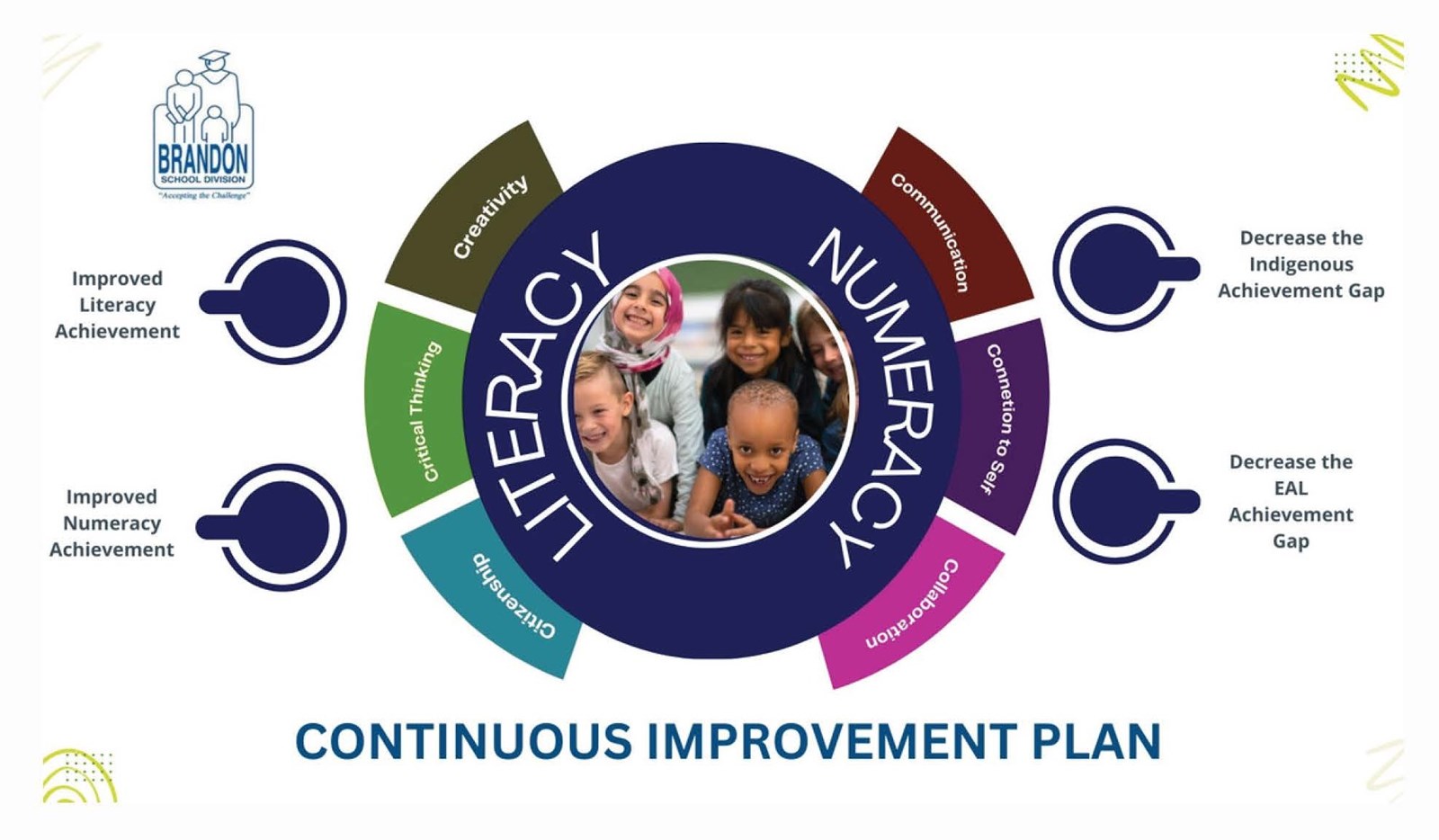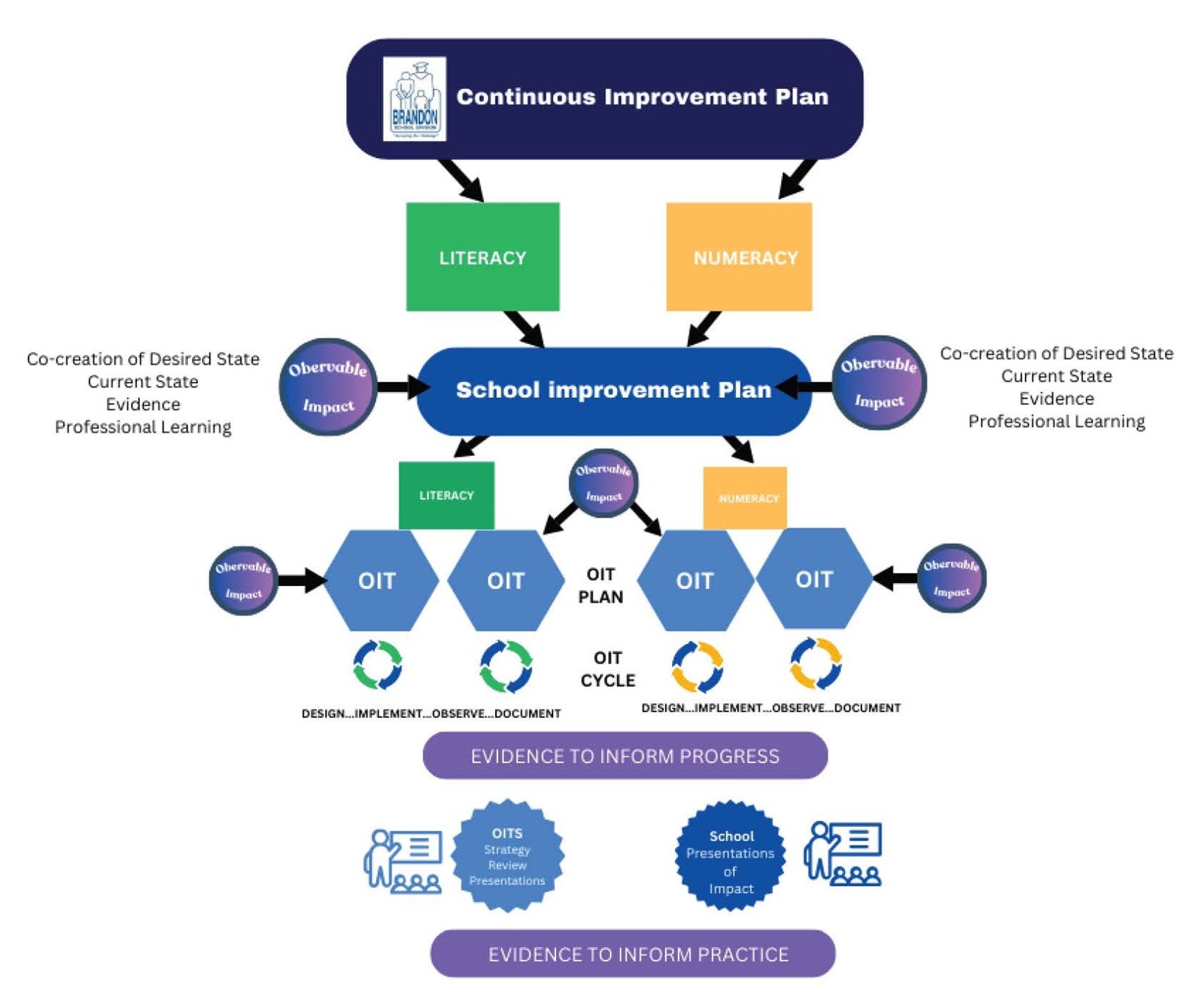Continuous Improvement in BSD
Brandon School Division recognizes that literacy and numeracy are the foundation for student success in school and in life. Division and provincial data, changing demographics, and educator feedback affirm the need for a continued focus on these essential skills.
Guiding Priorities
BSD’s work aligns with four key priorities:
- Closing the Indigenous Achievement Gap
- Closing the English as an Additional Language (EAL) Gap
- Improving Literacy Achievement
- Improving Numeracy Achievement
In response, BSD has strengthened collaboration and co-construction across schools and staff to enhance student growth. For full details, please view the 2025-2026 Continuous Improvement Handbook.

Vision of a Literate and Numerate Learner
BSD has co-constructed the Vision of a Literate Learner and Vision of a Numerate Learner—living frameworks that identify what proficiency looks like for both students and teachers. These documents articulate observable knowledge, skills, and behaviours aligned with the Manitoba Curriculum. The Vision provides guidance to support teachers in planning instruction and identifying high-yield literacy and numeracy practices that provide equitable learning opportunities for each student.
A Priority Renewal Process occurs every two to three years to gather field feedback and update the documents for clarity and relevance. The Senior Years Vision, to be completed by January 2026, will provide a K–12 continuum of literacy and numeracy proficiency. For full details, please view the Vision of a Literate and Numerate Learner documents.
Evidence Suite
Launching in the 2025–2026 school year, the Evidence Suite measures student growth in the specific observable indicators identified in the Vision of a Literate and Numerate Learner, focusing on writing (literacy) and problem solving (numeracy). Grades 1–4 will lead the first phase, with odd grades focusing on literacy and even grades on numeracy. Expansion to Grades 5–8 is planned for 2026–2027, and Grades 9–12 for 2027–2028, creating a full K–12 system of evidence-based growth measures. Assessments occur twice per year—in the fall and winter—to monitor progress and inform instructional planning.
The Evidence Suite provides baseline and longitudinal data that track the growth of each student across their years in the system. This helps teachers adjust instruction and supports planning at the classroom, school, and divisional levels. Using three lenses—conversations, observations, and products—educators gain a comprehensive picture of student learning and impact. For full details, please view the Evidence Suite Handbook.
Embedded Ongoing Adult Professional Learning
Observable Impact Teams (OITs)—facilitated in nearly all schools by Continuous Improvement Coaches (CICs)—engage educators in collaborative inquiry cycles connected to the Vision frameworks and student evidence. Educators test new practices, analyze student growth, and assess the impact of their actions on both student and educator targets. Learning is embedded, adaptive, and guided by impact.
Twice a year, educators participate in Strategy Review Presentations of Impact, sharing outcomes from their OIT cycles in mixed-grade cohorts. Using the Strategy Review Protocol (warms, wonders, connections, takeaways), colleagues exchange feedback, identify patterns, and celebrate growth.
Principals share their learning through two forms of impact presentations held each spring:
- School Presentations of Impact: highlight evidence of how school actions have influenced progress toward the identified desired state.
- Leadership Presentations of Impact: showcase principal growth in one of three leadership domains—capacity building, collaboration, or relationship building—and the resulting system-level impact.
K–12 administrators also meet bi-weekly to engage in system-connected learning that strengthens capacity, relationships, and collaborative structures across schools, ensuring that leaders grow alongside their staff in a shared culture of inquiry and impact.
Observable Impact Rounds
Observable Impact Rounds provide opportunities for teachers, school leaders, and divisional leaders to learn together by observing classroom practice connected to a school’s identified school plan focus. Host schools invite visiting teams to gather specific, descriptive, and non-judgmental observations using focus questions aligned with that plan. These observations help schools identify patterns, celebrate progress, and plan next steps for professional learning—fostering transparency, shared ownership, and system-wide collaboration.

Looking Ahead
Continuous Improvement in BSD is a culture of reflection, evidence, collaboration, and co-construction by adults. By integrating Vision frameworks, the Evidence Suite, Observable Impact Teams, and Impact Rounds, BSD ensures that every level of the system—student, teacher, and leader—works toward one shared goal: measurable, observable growth for each learner.
TO VIEW OUR 2024-2025 CONTINUOUS IMPROVEMENT REPORT, PLEASE VISIT: 2024-2025 BSD Continuous Improvement Report.
NOTE: For accessibility purposes, all Brandon School Division publications are available in alternative formats upon request. Email info@bsd.ca for more details. Should you have any difficulty accessing any of these documents, please email: info@bsd.ca.







